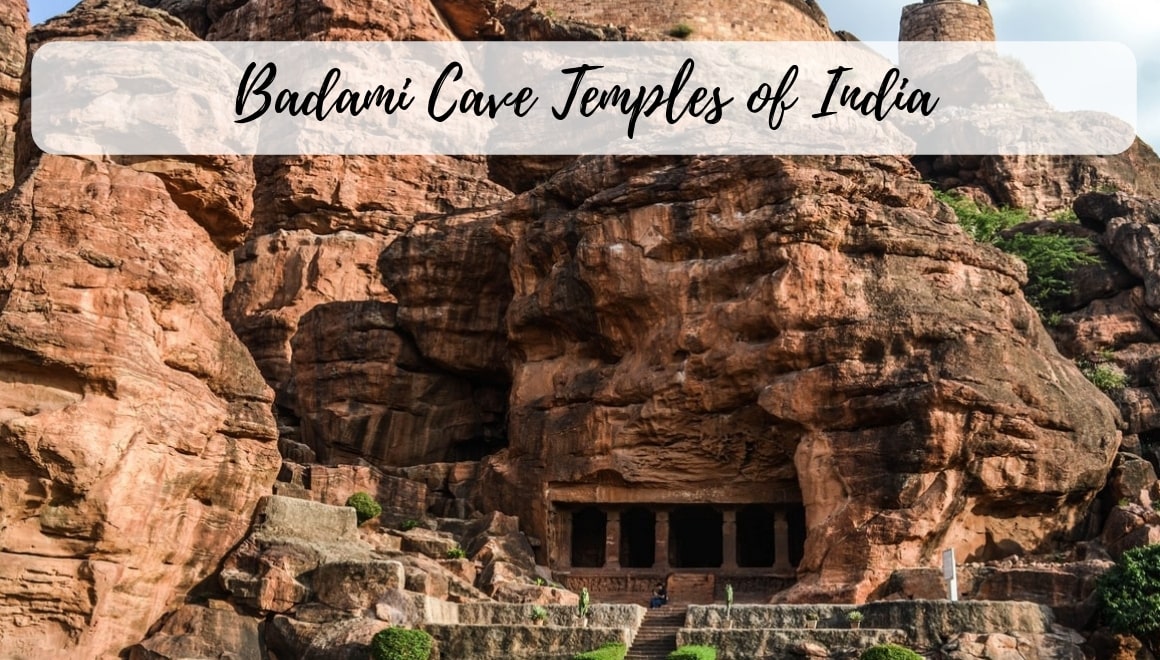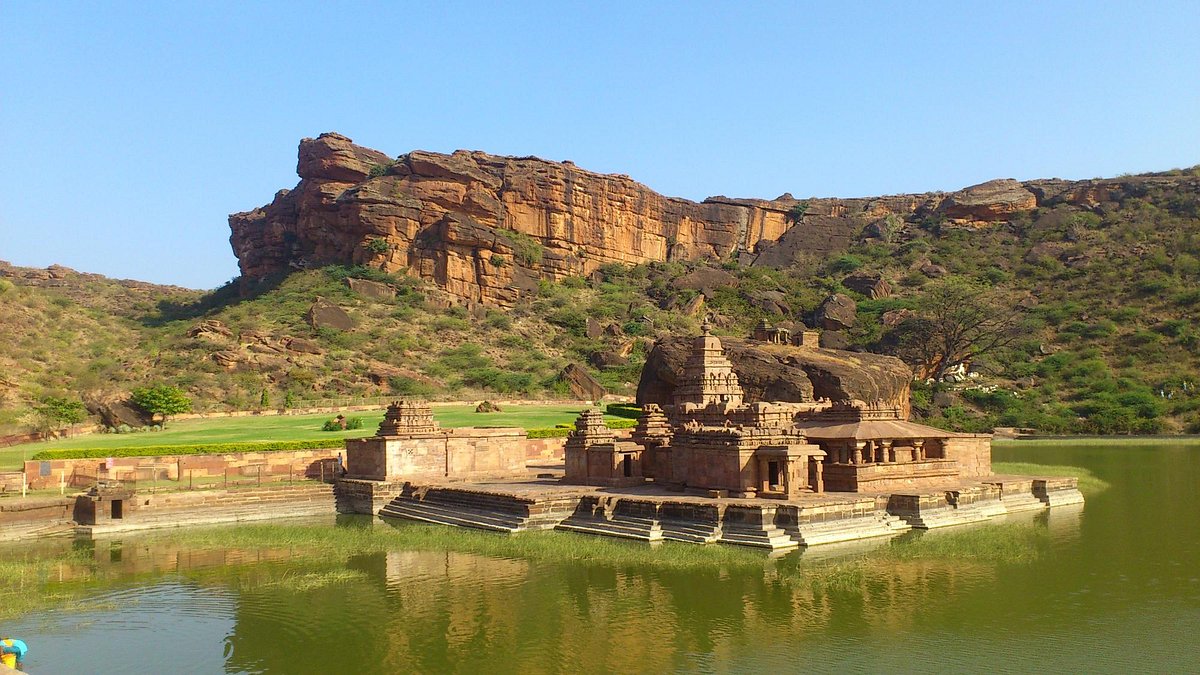Badami Caves, located in Karnataka, India, are a magnificent testament to ancient rock-cut architecture and religious art. These caves hold immense historical significance as they were carved out during the reign of the Chalukya dynasty in the 6th century. The architectural features of Badami Caves showcase a unique blend of North Indian Nagara and South Indian Dravidian styles. Cave Temples in Badami are adorned with intricate iconography and sculptures depicting various Hindu deities and mythological scenes. Frescoes and inscriptions within the Cave Temples provide valuable insights into the religious beliefs and practices of the time. Badami Cave 1 stands out for its impressive layout and design, with grand entranceways and stunning rock-cut pillars.
Cave 1 is dedicated to Lord Shiva and has a Lingam as its main deity, attracting countless devotees over the centuries. Comparatively, Cave 2 and Cave 3 offer different architectural styles, with Cave 2 featuring a unique Buddhist influence. Unique features of Cave 2 and Cave 3 include intricately carved ceilings, detailed friezes, and artistic depictions of Jain Tirthankaras. Badami Cave 4 is distinct from the others, as it served as a water reservoir rather than a temple, showcasing the engineering prowess of its creators. Artistic expressions in Cave 4 can be seen in the form of beautiful reliefs depicting mythological stories and scenes from daily life. Visiting Badami Caves promises a mesmerizing experience, where one can witness the rich heritage of Karnataka’s ancient past. Preservation efforts are crucial to ensure these caves continue to be significant cultural landmarks for future generations.
Historical significance of Badami Caves

The historical significance of Badami Caves lies in their creation during the 6th century by the Chalukya dynasty. These rock-cut caves showcase a fusion of North Indian Nagara and South Indian Dravidian architectural styles. They offer valuable insights into religious beliefs and practices through intricate iconography, sculptures, frescoes, and inscriptions. The caves attract devotees with Cave 1 dedicated to Lord Shiva, while Cave 2 features Buddhist influences. Cave 3 showcases detailed friezes and Jain Tirthankara depictions. Additionally, Cave 4 serves as a water reservoir, highlighting the engineering prowess of its creators.
Architectural features of Badami Caves
The architectural features of Badami Caves showcase a unique blend of North Indian Nagara and South Indian Dravidian styles. The rock-cut caves are carved into the sandstone cliffs, creating intricate and detailed structures. The caves feature elaborate pillars, ornate carvings, and beautifully sculpted figures. The craftsmanship and attention to detail in the architecture highlight the skill and creativity of the Chalukya dynasty. These architectural elements make the Badami Caves a remarkable site for both religious and historical exploration.
Cave Temples of Badami
The Cave Temples of Badami are a captivating sight, with their intricate architecture and rich historical significance. The temples feature stunning iconography and sculptures that depict various deities and mythological scenes. The walls of the caves are adorned with vibrant frescoes and inscriptions, offering a glimpse into the past. Each cave has its own unique layout and design, showcasing the mastery of the Chalukya dynasty. Exploring these cave temples is a truly immersive experience that transports you back in time to an era of artistic brilliance and spiritual devotion.
Iconography and sculpture in Cave Temples
The Cave Temples of Badami boast intricate iconography and sculptures that depict various deities and mythological scenes. These stunning artworks showcase the artistic brilliance of the Chalukya dynasty. The walls of the caves are adorned with vibrant frescoes and inscriptions, providing a glimpse into the rich history of the region. As you explore these cave temples, you will be transported back in time to an era of spiritual devotion and artistic mastery. Prepare to be captivated by the beauty and intricacy of the iconography and sculptures within these sacred caves.
Frescoes and inscriptions in Cave Temples

The Cave Temples of Badami are adorned with vibrant frescoes and inscriptions, adding to the visual grandeur of the sacred space. These exquisite artworks provide a glimpse into the rich history and cultural significance of the region. As you explore the cave temples, take a moment to appreciate the intricate details and stories depicted in these frescoes and inscriptions. They offer a unique insight into the beliefs and artistic traditions of the Chalukya dynasty. Immerse yourself in the beauty and symbolism of these ancient artworks as you delve deeper into the Badami Caves.
Badami Cave 1

Badami Cave 1 is a remarkable structure with a layout and design that captivates visitors. As you step inside, you’ll be greeted by intricate sculptures and carvings, showcasing the artistic brilliance of the Chalukya dynasty. Take your time to explore the various chambers and corridors, allowing yourself to absorb the religious significance and symbolism embedded in the cave. The grandeur and spiritual aura of Badami Cave 1 will undoubtedly leave a lasting impression on your journey through the magnificent Badami Caves.
Exploring the layout and design of Cave 1
As you explore the layout and design of Badami Cave 1, you’ll be captivated by its remarkable structure and intricate sculptures. The cave’s chambers and corridors showcase the artistic brilliance of the Chalukya dynasty. Take your time to absorb the religious significance and symbolism embedded in the cave’s carvings. The grandeur and spiritual aura of Badami Cave 1 will undoubtedly leave a lasting impression on your journey through the magnificent Badami Caves.
Religious significance of Cave 1
The religious significance of Cave 1 is evident through its intricate carvings and sculptures, which depict various deities and mythological scenes. The cave served as a place of worship for devotees, who would gather here to offer their prayers and seek blessings. The symbolism embedded in the carvings conveys profound spiritual messages, connecting the worshippers with their faith and beliefs. Exploring Cave 1 allows visitors to experience the sacred atmosphere and appreciate the religious devotion that permeates every corner of this ancient temple cave.
Badami Cave 2 and 3
Badami Cave 2 and 3 are two remarkable cave temples that showcase exquisite architecture and intricate carvings. Cave 2 is dedicated to Lord Vishnu, while Cave 3 is dedicated to Lord Mahavira. These caves feature elaborate sculptures depicting various deities, mythical creatures, and scenes from Hindu mythology. The detailed craftsmanship and attention to detail in these caves are truly awe-inspiring. Exploring the interior of Badami Cave 2 and 3 allows visitors to immerse themselves in the rich cultural and religious heritage of Karnataka. Don’t miss the opportunity to witness these incredible cave temples firsthand.
A comparative analysis of Cave 2 and Cave 3
Cave 2 and Cave 3 in Badami offer a fascinating comparative analysis. While Cave 2 is dedicated to Lord Vishnu, Cave 3 is dedicated to Lord Mahavira. The architectural styles of the two caves differ, with Cave 2 showcasing more intricate carvings and sculptures. Additionally, the iconography and depictions of deities vary between the two caves. Exploring both Cave 2 and Cave 3 allows visitors to appreciate the distinct features and artistic expressions of each temple. Don’t miss the chance to compare and contrast these remarkable cave temples in Badami.
Unique features of Cave 2 and Cave 3
Cave 2 and Cave 3 in Badami offer a fascinating comparative analysis. While Cave 2 is dedicated to Lord Vishnu, Cave 3 is dedicated to Lord Mahavira. The architectural styles of the two caves differ, with Cave 2 showcasing more intricate carvings and sculptures. Additionally, the iconography and depictions of deities vary between the two caves. Exploring both Cave 2 and Cave 3 allows visitors to appreciate the distinct features and artistic expressions of each temple. Don’t miss the chance to compare and contrast these remarkable cave temples in Badami.
Badami Cave 4
Special characteristics and purpose of Cave 4
Cave 4 in Badami is unique because it is the only cave that is not dedicated to a Hindu deity. Instead, it is believed to have been used as a Buddhist monastery during ancient times. The cave features a large hall with cells, pillars, and sculptures of Buddha and various Buddhist deities. Its layout and design reflect the simple yet elegant style of Buddhist architecture. Exploring Cave 4 provides a fascinating glimpse into the religious diversity of Badami and the region’s rich history.
Special characteristics and purpose of Cave 4
Cave 4 in Badami served as a Buddhist monastery, making it unique among the other caves dedicated to Hindu deities. Inside, you’ll find a large hall with cells, pillars, and sculptures of Buddha and various Buddhist deities. The simple yet elegant design reflects the Buddhist architectural style. Exploring Cave 4 offers a glimpse into the religious diversity and rich history of Badami.
Artistic expressions in Cave 4

Inside Cave 4, you will be amazed by the exquisite artistic expressions. The walls are adorned with intricate carvings and sculptures depicting scenes from Buddhist mythology. The attention to detail and the skill of the craftsmen is evident in every sculpture. The use of different materials like stone and stucco adds depth and texture to the artwork. As you explore, take a moment to appreciate the beauty and significance of these artistic expressions, which serve as a testament to the creativity and devotion of the ancient artisans.
Conclusion of The Beauty of Badami

After exploring the captivating Badami Caves and immersing yourself in its rich history and architectural marvels, it’s time to conclude your journey. Reflect on the awe-inspiring beauty of the cave temples, the intricate sculptures, and the vibrant frescoes that tell stories of ancient times. Consider recommending this extraordinary site to fellow travelers, emphasizing the need for its preservation. The Badami Caves are not just a testament to Karnataka’s cultural heritage but also a remarkable reminder of the artistic brilliance of our ancestors. Cherish this experience and continue to spread the wonder of Badami to others.
Overall experience and recommendations for visiting Badami Caves

Overall experience and recommendations for visiting Badami Caves:
- Immerse yourself in the rich history and architectural marvels of the cave temples.
- Marvel at the intricate sculptures that showcase the artistry of ancient times.
- Explore the vibrant frescoes and inscriptions that tell stories of a bygone era.
- Take your time to appreciate the layout and design of each cave, particularly Cave 1 with its religious significance.
- Compare and contrast the unique features of Cave 2 and Cave 3.
- Don’t miss Cave 4, known for its special characteristics and artistic expressions.
- Spread the wonder of Badami to fellow travelers and emphasize the need for its preservation.
Remember, the Badami Caves are not just a testament to Karnataka’s cultural heritage but also a remarkable reminder of our ancestors’ artistic brilliance.
Preservation efforts and significance of Badami caves in Karnataka

To ensure the preservation of the Badami caves and their significance in Karnataka, various efforts have been made. These include regular maintenance and conservation work, such as cleaning, repairing, and protecting the cave structures. The local government and archaeological authorities have also implemented measures to control visitor access and prevent damage to the caves. Additionally, awareness campaigns and educational programs have been conducted to promote the cultural and historical value of the caves, emphasizing their importance to both locals and tourists. It is crucial for visitors to respect and support these preservation efforts to safeguard this precious heritage for future generations.
The Beauty of Badami
For More Blogs visit Hillw
